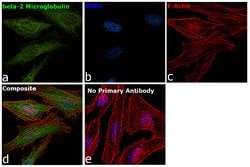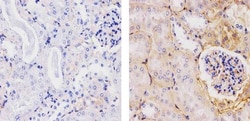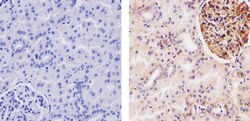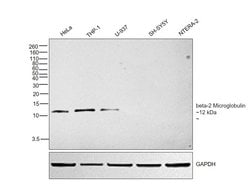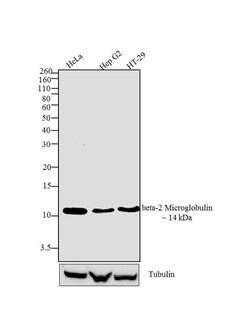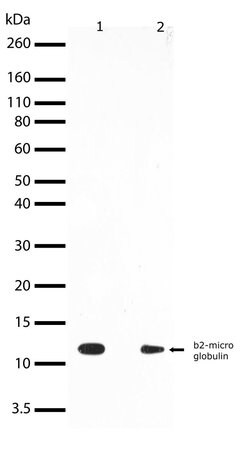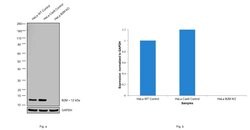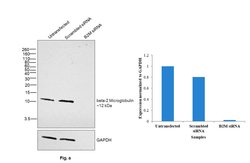Learn More
Invitrogen™ beta-2 Microglobulin Recombinant Rabbit Monoclonal Antibody (4H5L6)
Rabbit Recombinant Monoclonal Antibody
Supplier: Invitrogen™ 701250
Description
This antibody is predicted to react with non-human primate, mouse and rat based on sequence homology. Intact IgG appears on a non-reducing gel as ~150 kDa band and upon reduction generating a ~25 kDa light chain band and a ~50 kDa heavy chain. Recombinant rabbit monoclonal antibodies are produced using in vitro expression systems. The expression systems are developed by cloning in the specific antibody DNA sequences from immunoreactive rabbits. Then, individual clones are screened to select the best candidates for production. The advantages of using recombinant rabbit monoclonal antibodies include: better specificity and sensitivity, lot-to-lot consistency, animal origin-free formulations, and broader immunoreactivity to diverse targets due to larger rabbit immune repertoire.
Beta-2-microglobulin (B2M) is a 12-14 kDa protein that is a subunit of the major histocompatibility complex (MHC) class I. Human beta 2 Microglobulin associated with HLA Class I antigens are expressed on many types of cells including lymphocytes, thymocytes, monocytes, granulocytes, platelets, endothelial cells, and epithelial cells, but is absent on erythrocytes. Beta-2 microglobulin is also found in free form in the plasma. The amino acid sequence of Beta-2-microglobulin is homologous to the constant regions of immunoglobulin heavy and light chains, with a predominantly beta pleated sheet structure. The protein is ubiquitously expressed in the cytoplasm, and is involved in antigen processing and presentation. Beta-2-microglobulin also plays a role in TCR signaling, and downstream signaling in naive CD8+ cells. Beta 2-microglobulin is encoded by the B2M gene located on chromosome 15. A mutation in the Beta-2-microglobulin gene has been shown to result in hypercatabolic hypoproteinemia. Levels of beta 2 microglobulin can be used to assess renal function in kidney transplant recipients. Beta-2-microglobulin that protein can be used as a prognostic marker for HIV infection.
Specifications
| beta-2 Microglobulin | |
| Recombinant Monoclonal | |
| 0.5 mg/mL | |
| PBS with 0.09% sodium azide | |
| P01887, P61769 | |
| B2m | |
| Recombinant protein corresponding to amino acids 21-119 of human b2-microglobulin. | |
| 100 μg | |
| Primary | |
| Human, Mouse | |
| Antibody | |
| IgG |
| Immunohistochemistry (Paraffin), Western Blot, Immunocytochemistry | |
| 4H5L6 | |
| Unconjugated | |
| B2m | |
| B2m; B2-microglobulin; b2m-W01; b2m-W03; b2m-Z01; b2m-Z02; b2m-Z03; Beta 2 microglobin; Beta 2 microglobulin; beta 2-microglobulin; beta chain of MHC class I molecules; Beta2 microglobulin; beta-2 microglobulin; beta-2 microglobulin preprotein; beta2m; beta2-m; beta-2-microglobin; beta-2-microglobulin; beta-2-microglobulin C-terminal fragment (55 AA); Beta-2-microglobulin form pI 5.3; B-F; CDABP0092; HDCMA22P; IMD43; Lactollin; Ly-m11; MHC Class I; microglobulin beta-2; Orla-B2m | |
| Rabbit | |
| Protein A | |
| RUO | |
| 12010, 567 | |
| Store at 4°C short term. For long term storage, store at -20°C, avoiding freeze/thaw cycles. | |
| Liquid |
Your input is important to us. Please complete this form to provide feedback related to the content on this product.
